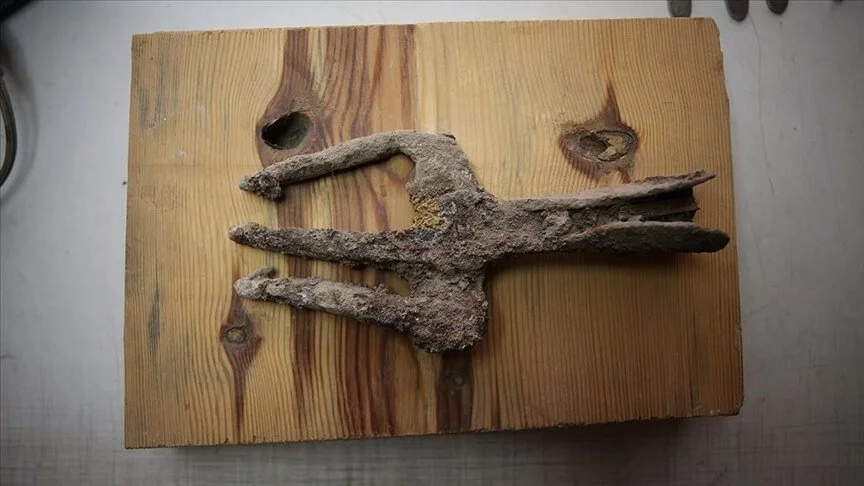Archaeologists in the northwestern region of Turkey have recently made a captivating discovery in the ancient city of Assos, shedding new light on the historical significance of this remarkable site. The find in question is an ancient iron trident, believed to have been used for fishing, that dates back an astonishing 1,700 years. This trident's unearthing is not only a testament to the city's rich history but also a rare glimpse into the tools and practices of ancient fishermen.
Assos, situated in the Ayvacik district of Canakkale, is renowned for its well-preserved ancient ruins and artifacts from both the Roman and Byzantine eras. The ongoing excavations in this ancient city are being carried out under the guidance of Nurettin Arslan, a professor specializing in humanities and social sciences at Canakkale Onsekiz Mart University. The Turkish Ministry of Culture and Tourism and the Turkish Historical Society have provided essential support for this archaeological endeavor.
The team of dedicated archaeologists stumbled upon this extraordinary artifact during their excavations in the eastern part of the city, specifically in an area known as the Nymphaion, or eastern fountain. The trident was concealed beneath layers of soil and subjected to oxidization over the centuries. To unveil its historical significance, an expert restorer meticulously worked on cleaning and preserving this remarkable piece.
Professor Arslan explained that while iron tridents are frequently depicted in murals and other ancient depictions, this was the first time such a tool had been discovered in Assos. Iron, being susceptible to rapid decay, is typically scarce in ancient city excavations. This rarity makes the Assos trident a significant find, as it provides valuable insights into the fishing techniques of the time.
Arslan went on to describe how these tridents were likely employed by ancient fishermen, who would venture out to sea in small boats illuminated by torchlight at night to catch large fish. The tridents would have been essential tools in this daring and skillful pursuit.
Determining the precise origin of the trident remains challenging due to its iron composition. Iron was widely available and produced across various regions, making it difficult to pinpoint its place of production. However, Assos has yielded numerous discoveries of iron slag and iron forging, suggesting that this particular trident might have been crafted within the city itself.
This remarkable discovery further cements Assos's status as a treasure trove of historical and archaeological wonders. The ongoing excavations promise to reveal more about this ancient city's past, offering a glimpse into the lives and practices of those who once called Assos home.
As archaeologists continue to unearth and study these fascinating artifacts, Assos remains a captivating destination for history enthusiasts and curious travelers eager to explore Turkey's rich cultural heritage. The ancient trident serves as a tangible link to the past, allowing us to connect with the experiences and tools of our ancestors in this beautiful and historically significant part of the world.
Key aspects of the ancient city of Assos
The ancient city of Assos, also known as Behramkale in modern-day Turkey, is a historically and archaeologically significant site located in the northwestern part of the country. Assos is situated in the Ayvacik district of Canakkale Province, near the Aegean Sea. This ancient city is renowned for its well-preserved ruins and the insights it provides into the history and culture of the ancient world.
Assos has a rich and diverse history that spans several millennia. It was originally founded by Aeolian settlers from the island of Lesbos in the 8th century BCE. Over the centuries, Assos was ruled by various powers, including the Persians, Athenians, and Macedonians.
One of the most famous aspects of Assos's history is its association with the ancient Greek philosopher Aristotle. He spent some time in Assos and established a philosophical school there. The Temple of Athena in Assos is believed to have been the location of Aristotle's school, where he taught his disciples.
Assos is known for its impressive architectural remains. The Temple of Athena, which dates back to the 6th century BCE, is one of the most iconic structures. It features doric columns and offers breathtaking views of the surrounding landscape. Additionally, there are well-preserved city walls, a theater, and other ancient structures.
The city's strategic location overlooking the Aegean Sea made it an important center for trade and commerce in antiquity. Its position on a hill provided natural defenses against potential invaders and offered stunning vistas of the sea.
Roman and Byzantine Influence: Assos continued to thrive during the Roman and Byzantine periods, with various monuments and buildings added during these eras. The city served as a regional center and played a role in the Byzantine Empire's history.
Modern archaeological excavations have been conducted in Assos since the late 19th century, uncovering numerous artifacts and providing valuable insights into the city's history. These excavations continue to this day, revealing new details about Assos's past.
Today, Assos is a popular tourist destination, attracting visitors from around the world who are interested in its historical and cultural heritage. The well-preserved ruins, picturesque landscapes, and serene atmosphere make it an ideal place for exploration and reflection.
Assos's historical significance has led to efforts to preserve and protect its archaeological remains. Conservation projects and initiatives aim to safeguard the city's heritage for future generations.
Visiting the ancient city of Assos allows travelers to step back in time and experience the grandeur of ancient Greek and Roman civilizations. The combination of its historical significance, architectural marvels, and scenic beauty makes Assos a must-visit destination for history enthusiasts and tourists exploring the rich history of Turkey.








